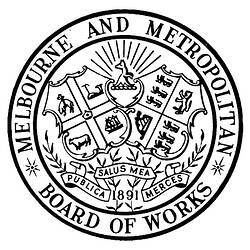Summary
Print of a hand coloured general arrangement drawing of the Melbourne & Metropolitan Board of Works sewerage pumping station at Spotswood. It shows details of the North & South Engine Houses, Boiler Houses and Coal Bunkers The original drawing was completed in 1899. This copy is dated 3 October 1917 and is signed by Calder Oliver (1855-1930), MMBW Engineer-in-Chief. The Pumping Station is now incorporated within Scienceworks operated by Museum Victoria since 1992.
Physical Description
Coloured plan drawing on heavy fabric-backed paper. Shows East frontage and ground plan with four smaller elevation drawings on right side.
Significance
The Spotswood Sewerage Pumping Station was constructed for the Melbourne & Metropolitan Board of Works (MMBW) between 1893 and 1897, as part of Melbourne's first centralised sewerage system. In 1891, the Melbourne & Metropolitan Board of Works was formed, and construction of the city's first centralised sewerage system began. From its official opening in February 1898, the Spotswood Pumping Station served for 67 years as the heart of Melbourne's sewerage system, pumping wastewater collected in underground sewers from homes, factories, stables and businesses throughout Melbourne to a treatment farm at Werribee.
The Brooklyn Pumping Station in Millers Road was built to take over the function of pumping sewerage to the Werribee Treatment Works from the Spotswood Pumping Station, and progressively came on line during 1964-1965. Subsequently, the old Spotswood Pumping Station site continued to be used as an engineering workshop for the MMBW maintaining pumping equipment from smaller auxiliary pumping stations and mobile construction equipment until about 1982. The Spotswood Pumping Station buildings and their entire contents were classified by the National Trust of Australia in 1981. The site was transferred to the care of the Museum of Victoria on 2 March 1989.
More Information
-
Collection Names
Spotswood Pumping Station Archives, Spotswood Pumping Station Collection
-
Collecting Areas
-
Acquisition Information
Donation from Mr Len Thomas, 07 May 2010
-
Commissioned By
Spotswood Pumping Station, Melbourne & Metropolitan Board of Works (MMBW), Spotswood, Greater Melbourne, Victoria, Australia, 1899
-
Other Association (See Comments)
Calder Oliver, Spotswood, Greater Melbourne, Victoria, Australia, 3 Oct 1917
Signed by -
Designer of Item Depicted
Mr Christian Kussmaul - Melbourne & Metropolitan Board of Works, Melbourne, Greater Melbourne, Victoria, Australia, circa 1893
Designer of the Spotswood Pumping Station buildings. -
Inscriptions
Titled: 'MELBOURNE & METROPOLITAN BOARD OF WORKS, PUMPING STATION SPOTTISWOODE, PLAN of ENGINE HOUSE, BOILER HOUSE & COAL BUNKERS, Scale 20'-1-Inch. Dated 1899 and 3/10/1917. Facimile signatures of William Thwaites and Calder Oliver.
-
Classification
-
Category
-
Discipline
-
Type of item
-
Overall Dimensions
695 mm (Width), 410 mm (Height)
-
Keywords
Plan Drawings, Sewerage, Sewerage Pumping Stations, Spotswood Sewerage Pumping Station

